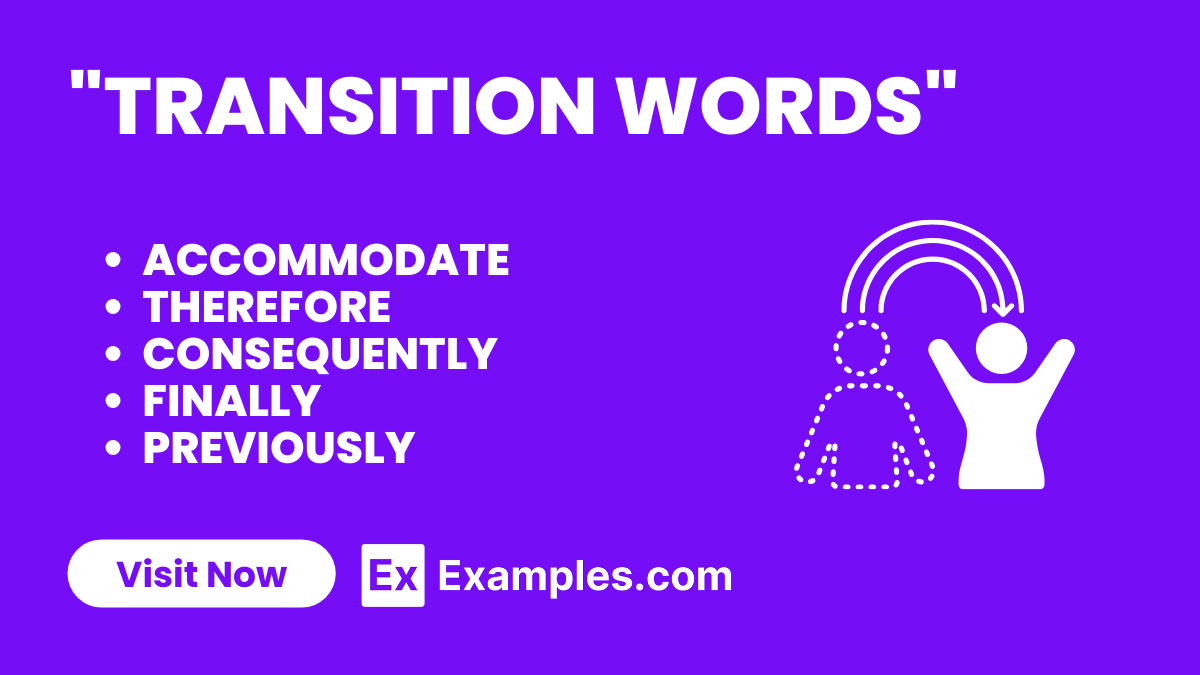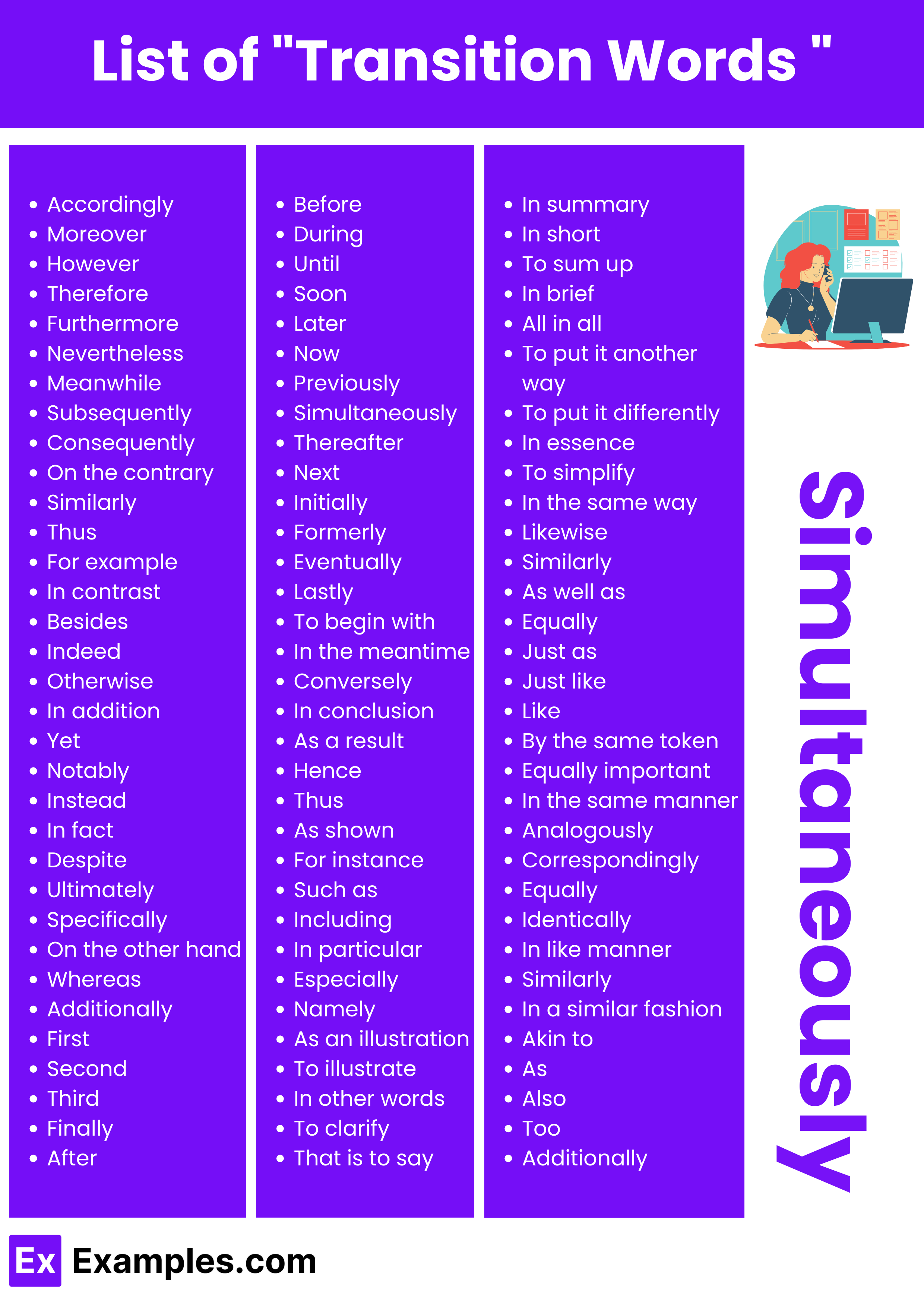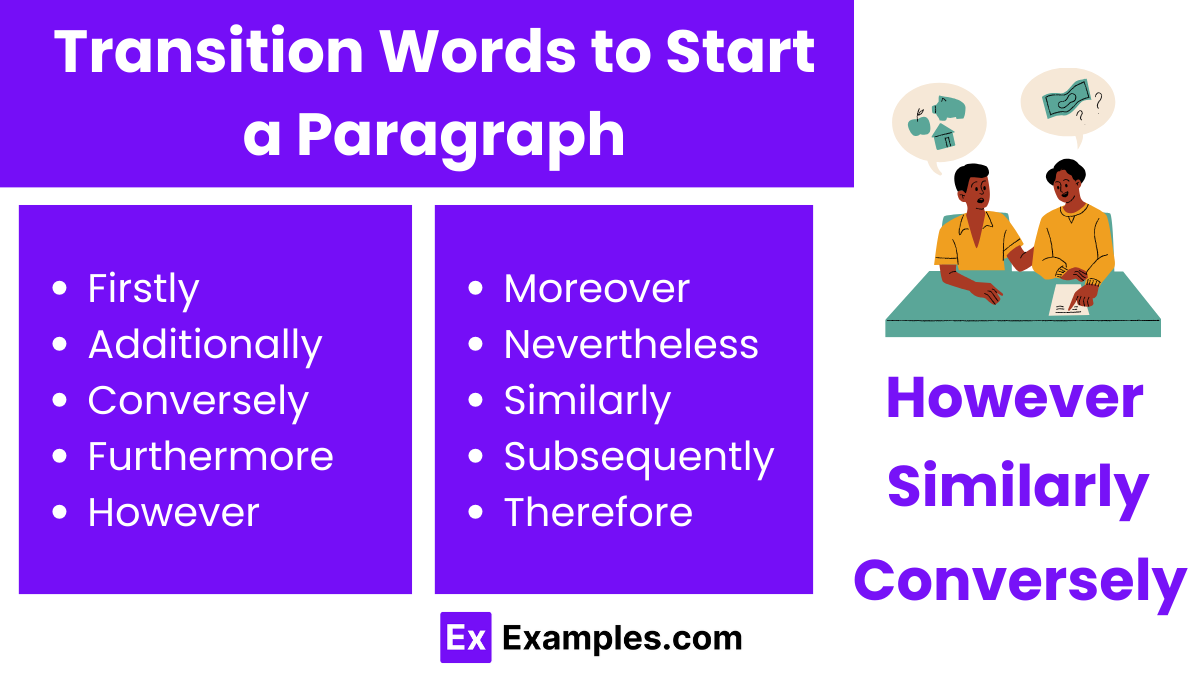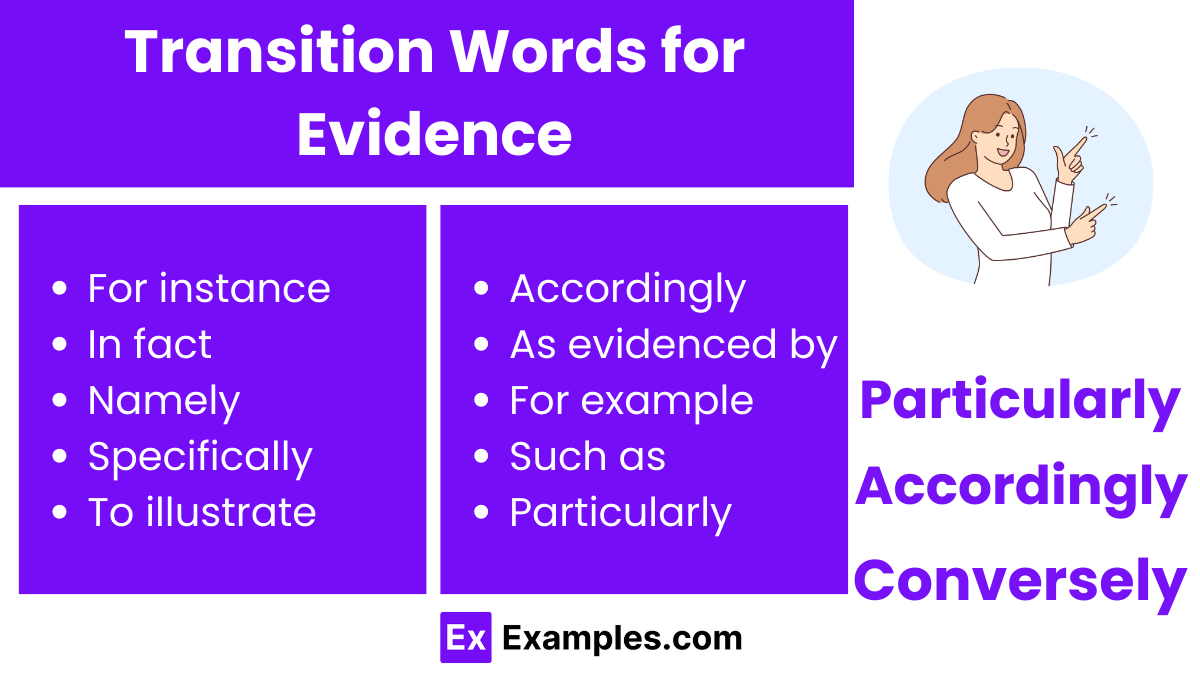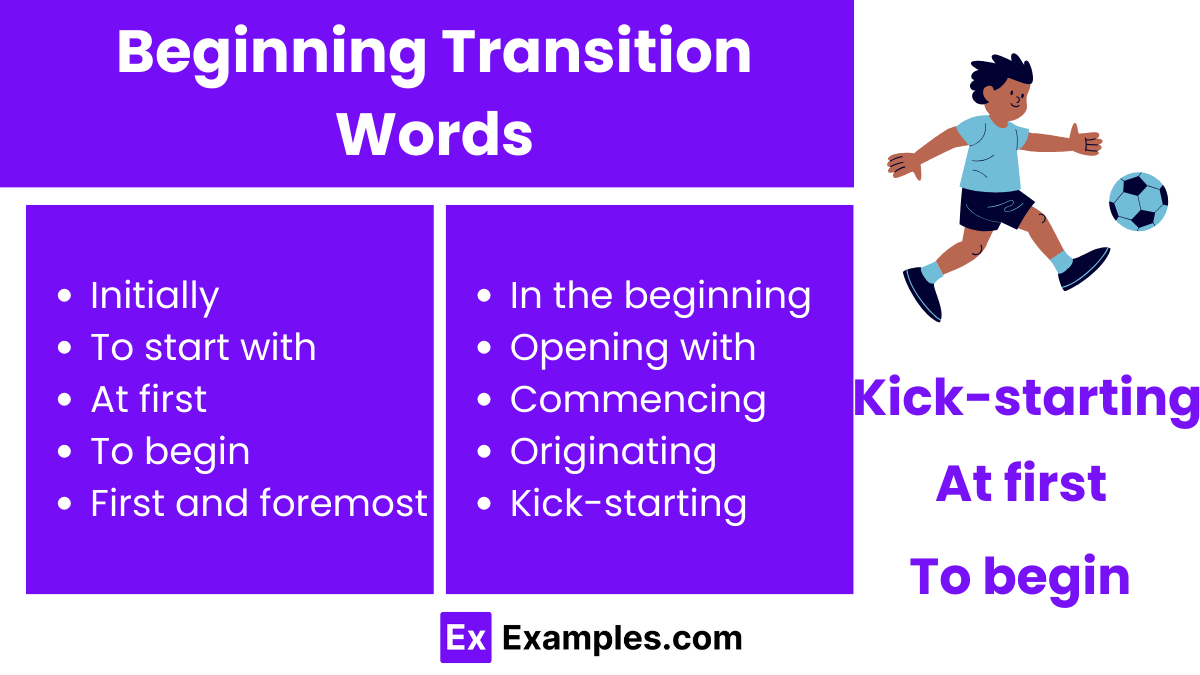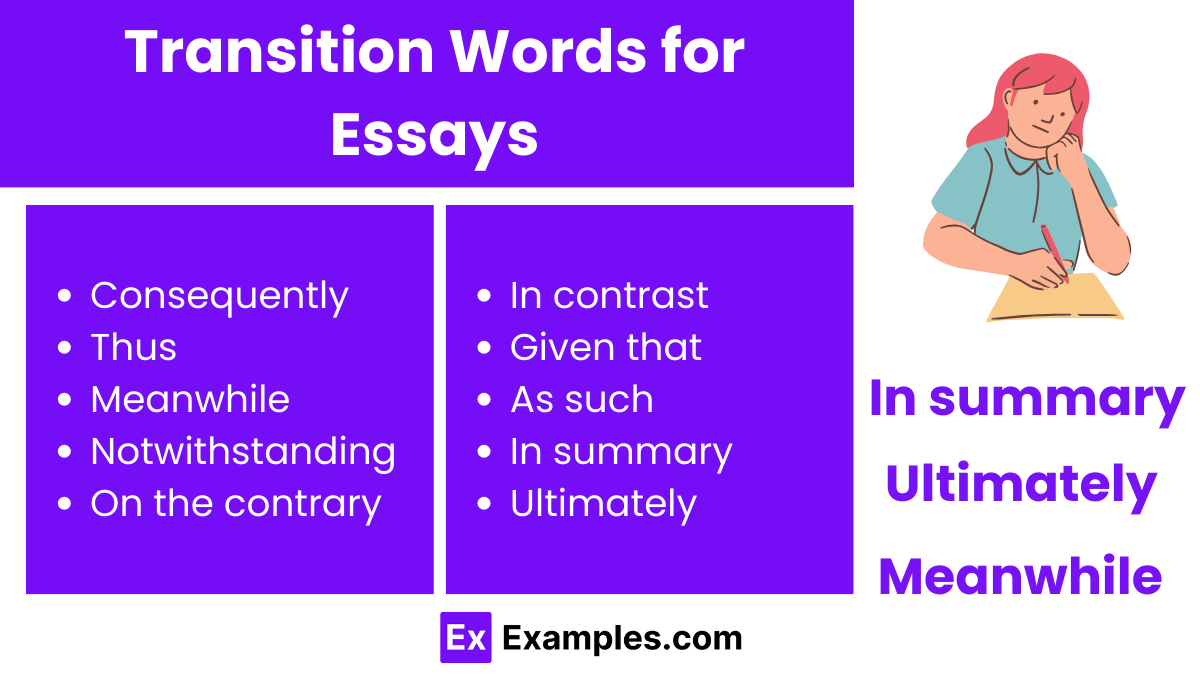450+ Transition Words List, Meaning, PDF
Dive into the world of transition words, the linguistic bridges that seamlessly connect ideas, sentences, and paragraphs, guiding readers through a coherent flow of thoughts. These pivotal words and phrases, ranging from ‘however’ and ‘therefore’ to ‘meanwhile’ and ‘consequently’, are the unsung heroes of clear and effective communication. Whether in essays, stories, or speeches, mastering transition words empowers writers and speakers to weave complex ideas into a tapestry of understanding, enhancing readability and engagement.
Download List of Transition Words - PDF
100 List of “Transition Words “
Transition words are the threads that weave together sentences and paragraphs into a cohesive tapestry of ideas, ensuring clarity and smooth flow in writing and speech. These pivotal linguistic tools guide readers and listeners through the progression of thoughts, effectively signaling shifts in time, contrasts, comparisons, conclusions, and more. They are indispensable in crafting compelling narratives, persuasive arguments, and clear expository texts, serving as bridges that connect disparate ideas into a unified whole. From signaling a causal relationship with “because” and “therefore” to contrasting ideas with “however” and “on the other hand,” transition words are the backbone of eloquent and effective communication. They not only enhance readability but also enrich the content, making complex information accessible and engaging. For students and educators alike, mastering the use of transition words is a key step in developing advanced writing skills and fostering a deeper understanding of language mechanics. This exploration into transition words opens up a world of possibilities for expressing ideas with precision, nuance, and dynamism, elevating the art of communication.
| accordingly | moreover | however | therefore |
| furthermore | nevertheless | meanwhile | subsequently |
| consequently | on the contrary | similarly | thus |
| for example | in contrast | besides | indeed |
| otherwise | in addition | yet | notably |
| instead | in fact | despite | ultimately |
| specifically | on the other hand | whereas | additionally |
| first | second | third | finally |
| after | before | during | until |
| soon | later | meanwhile | now |
| previously | simultaneously | thereafter | next |
| initially | formerly | eventually | lastly |
| to begin with | in the meantime | conversely | in conclusion |
| as a result | hence | thus | as shown |
| for instance | such as | including | in particular |
| especially | namely | as an illustration | to illustrate |
| in other words | to clarify | that is to say | in summary |
| in short | to sum up | in brief | all in all |
| to put it another way | to put it differently | in essence | to simplify |
| in the same way | likewise | similarly | as well as |
| equally | just as | just like | like |
| by the same token | equally important | in the same manner | analogously |
| correspondingly | equally | identically | in like manner |
| similarly | in a similar fashion | akin to | as |
| also | too | additionally | furthermore |
| moreover | plus | along with | not only but also |
| both and | not to mention | as well as | including |
| also | and | too | as well as |
| either or | neither nor | whether or | but also |
Transition Words to Start a Paragraph
Starting a new paragraph with the right transition word can set the tone and direction, making your writing cohesive and easy to follow. These words act as signposts, guiding readers from one idea to the next, and are essential for maintaining a logical flow in essays, reports, and narratives.
- Firstly – Introduces the initial point or argument.
- Additionally – Adds another point to the previous one.
- Conversely – Indicates a contrast to the previous idea.
- Furthermore – Expands on the information given.
- However – Introduces a contrasting idea.
- Moreover – Adds emphasis to the point being made.
- Nevertheless – Presents a contrasting point despite what has been said.
- Similarly – Introduces an idea that is alike to the previous one.
- Subsequently – Indicates the next point in a sequence.
- Therefore – Introduces a conclusion or a result based on the information given.
Transition Words for Evidence
Incorporating evidence is crucial in supporting arguments, and using the right transition words ensures that your evidence is seamlessly integrated into your narrative, bolstering your claims effectively.
- For instance – Introduces an example as evidence.
- In fact – Presents factual evidence to support a claim.
- Namely – Specifies information as evidence.
- Specifically – Points out detailed evidence.
- To illustrate – Introduces evidence as an example.
- Accordingly – Shows evidence that leads to a conclusion.
- As evidenced by – Introduces proof supporting an argument.
- For example – Provides an instance as evidence.
- Such as – Introduces examples or evidence.
- Particularly – Highlights specific evidence.
Beginning Transition Words
Effective writing starts with engaging beginnings. These transition words are perfect for initiating sentences, paragraphs, or sections, ensuring a smooth entry into your ideas and arguments.
- Initially – Marks the beginning of a series of points.
- To start with – Introduces the first point.
- At first – Indicates the initial standpoint.
- To begin – Opens the discussion.
- First and foremost – Emphasizes the primary point.
- In the beginning – Sets the stage for the upcoming narrative.
- Opening with – Starts with a specific point or idea.
- Commencing – Begins the discussion or argument.
- Originating – Introduces the origin or start of an idea.
- Kick-starting – Energizes the beginning of a narrative or argument.
Transition Words for Essays
Transition words are instrumental in structuring essays, ensuring that ideas flow logically and clearly from one to another, making arguments more persuasive and narratives more coherent.
- Consequently – Shows the result of a given situation.
- Thus – Concludes an argument or a point.
- Meanwhile – Indicates simultaneous events or ideas.
- Notwithstanding – Introduces an idea despite the previous points.
- On the contrary – Introduces a contrasting idea.
- In contrast – Highlights differences between two points.
- Given that – Introduces a condition or premise.
- As such – Concludes an idea based on the previous statement.
- In summary – Begins a conclusive summary of the essay.
- Ultimately – Introduces the final point or conclusion.
Perspective Transition Words
Perspective transition words are linguistic keystones that pivot the narrative, offering fresh viewpoints or shifting the lens through which a topic is explored. These words are crucial in academic writing, debates, and analytical discussions, allowing writers and speakers to gracefully navigate between different perspectives, compare viewpoints, and introduce alternative or contrasting ideas. For educators, teaching these transitions empowers students to construct multifaceted arguments and enriches their critical thinking skills, enabling them to present and evaluate diverse perspectives effectively.
- Alternatively – Introduces a different viewpoint or option.
- Conversely – Presents an opposing or contrasting perspective.
- From another perspective – Offers a new viewpoint on the topic.
- On the other hand – Introduces a contrasting idea or argument.
- Contrarily – Indicates a contrary viewpoint or argument.
- Viewed from this angle – Suggests considering the topic from a specific perspective.
- In contrast – Highlights a difference in viewpoints or ideas.
- On the flip side – Introduces an alternate side or aspect of an argument.
- Alternatively considered – Suggests another way of looking at the issue.
- Looking at it differently – Encourages considering the topic from an alternate viewpoint.
Types of Transition Words
These transition words and phrases serve as bridges between ideas, ensuring the content is coherent and the progression of thoughts is logical and smooth.
| Type | Function | Examples |
|---|---|---|
| Additive | Introduce additional information | Moreover, Furthermore, Additionally |
| Contrast | Show opposition or contrasting ideas | However, On the contrary, Nevertheless |
| Cause and Effect | Demonstrate causality | Therefore, Consequently, As a result |
| Sequence/Order | Indicate sequence or order of events | First, Next, Lastly |
| Time | Denote timing or temporal aspects | Meanwhile, Subsequently, Eventually |
| Example | Provide illustrations or examples | For instance, To illustrate, Such as |
| Emphasis | Highlight importance or urgency | Importantly, Indeed, In fact |
| Conclusion/Summary | Summarize or conclude ideas | In conclusion, To summarize, In summary |
| Comparison | Draw comparisons | Similarly, Likewise, Just as |
| Clarification | Clarify or explain further | In other words, To clarify, That is to say |
In conclusion, transition words are the linchpins of eloquent communication, seamlessly connecting ideas and ensuring the smooth flow of narratives. Mastering their use can transform writing and speech, making complex ideas more accessible and engaging. They are essential tools for anyone looking to enhance their language skills, providing clarity, coherence, and sophistication to any form of expression.



